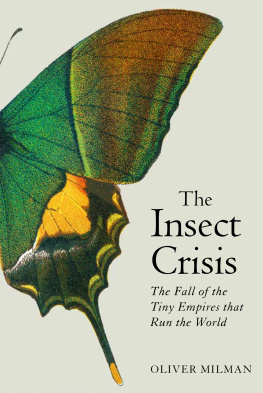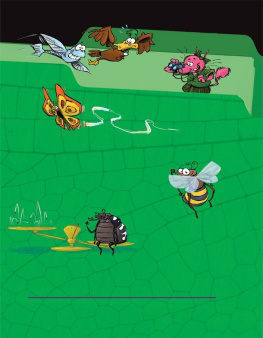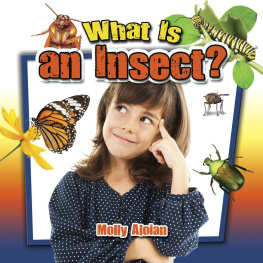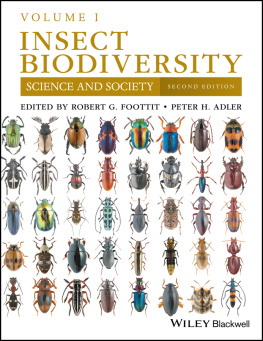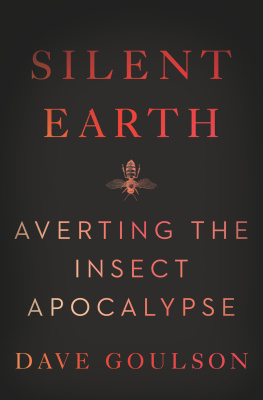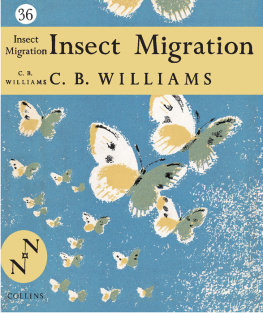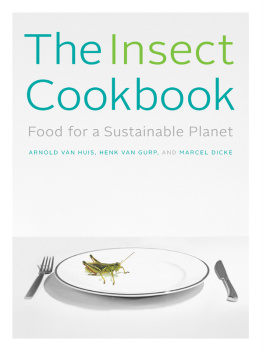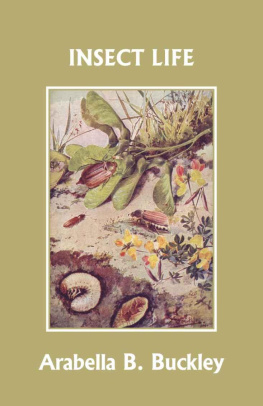ACKNOWLEDGMENTS
Writing a first book is a daunting enough prospect even without the added challenge of doing it during a historic pandemic, so Im grateful and relieved I was able to finish this when so many of us, to varying degrees of trauma, have struggled.
Any writing about the environment, including the insect world, is best done having been immersed in the sights, sounds, and smells of ecosystems and I was fortunate to have undertaken some remarkable journeys for this book shortly before the shutters came down on meaningful travel.
A special thanks has to go to those who helped me navigate these places, including Cuauhtmoc Senz-Romero, who allowed me to traipse around the mountains of central Mexico with him looking at oyamel fir trees and monarch butterflies. I was treated with hospitality and kindness at the home of Ramirez Cruz, known locally as Don Pancho, and was saddened to learn of his death from cancer just eight months after my trip to Mexico.
Floyd Shockley was an erudite and friendly guide around the National Museum of Natural Historys sprawling vaults of insects, Jay Evans assisted ably with my questions and flailing attempts to get into a beekeeping suit, and Denise Qualls was good enough to offer her insights, a bag of almonds, and a kind word after I was stung on the face in the twilight of a day spent with bees in Californias Central Valley. George Hansen, a no-nonsense beekeeper, was a good mixture of pleasant company and forthright views, as was Art Shapiro on our butterfly-less yet enjoyable walk.
Attempting to write about the lives of creatures as multifaceted and yet, in many cases, obscure as insects requires plenty of expert guidance, and Im grateful to the many entomologists and other scientists who helped with basic points of accuracy. Particular thanks go to Matt Forister, Alex Lees, Erica McAlister, Dave Goulson, Simon Potts, Alex Zomchek, Anders Pape Moller, Chris Looney, and Stefanie Christmann, among others, for their time and patience. Im thankful that Conrad Berube was able to stand my repeated questions about what it was like being attacked by murder hornets and that Coby Schal persisted in his defense of cockroaches.
The genesis of this book has plenty to do with the instincts and hard work of Zo Pagnamenta and her superb team, while the shape and structure of it was expertly influenced by the great Quynh Do. The latter stages of this process were adroitly overseen by Melanie Tortoroli at Norton. Im grateful to them all for their advice and guidance.
While this book encompasses a grand sweep around the world, most of it was written in a small apartment in Brooklyn that was, outside, roiled by a rampant virus and antiracism protests and, inside, often a maelstrom due to two young children and a neurotic sausage dog. My biggest thanks and credit, therefore, need to go to my wonderful wife, Lyndal, for her love, support, and sheer endurance.
NOTES
1: AN INTRICATE DANCE
Within a few decades the world would return: Edward O. Wilson, The Little Things That Run the World (The Importance and Conservation of Invertebrates), Conservation Biology 1, no. 4 (1987): 345.
.
.
Scientists have harnessed maggots: K. Y. Mumcuoglu, Clinical Applications for Maggots in Wound Care, American Journal of Clinical Dermatology 2, no. 4 (2001): 219.
oil has been extracted from the larvae: Qing Li et al., From Organic Waste to Bio-diesel: Black Soldier Fly, Hermetia illucens, Makes It Feasible, Fuel 90, no. 4 (2011): 1545.
.
.
the African Matabele ants: Erik Thomas Frank et al., Saving the Injured: Rescue Behavior in the Termite-Hunting Ant Megaponera analis, Science Advances 3, no. 4 (2017), accessed February 25, 2021, doi:10.1126/sciadv.1602187.
Honeybees understand the concept of zero: Scarlett R. Howard et al., Numerical Ordering of Zero in Honey Bees, Science 360, no. 6393 (2018): 1124.
.
estimates vary from an eye-watering 30 million species: Nigel E. Stork, How Many Species of Insects and Other Terrestrial Arthropods Are There on Earth?, Annual Review of Entomology 63 (2018): 31.
In 2016, Canadian scientists completed a DNA analysis: Paul D. N. Hebert et al., Counting Animal Species with DNA Barcodes: Canadian Insects, Philosophical Transactions of the Royal Society B 371, no. 1702 (2016), accessed February 25, 2021, doi. org/10.1098/rstb.2015.0333.
.
.
scrunched them into a giant ball: Yinon M. Bar-On, Rob Phillips, and Ron Milo, The Biomass Distribution on Earth, Proceedings of the National Academy of Sciences of the USA 15, no. 25 (2018): 6506.
Todays human population is adrift in a sea of insects,: Larry Pedigo and Marlin Rice, Entomology and Pest Management, 6th ed. (Long Grove, IL: Pearson College Division, 2008), 1.
.
.
A warning shot was fired in 2014: Roldofo Dirzo et al., Defaunation in the Anthropocene, Science 345, no. 6195 (2014): 401.
.
.
.
.
.
.
.
.
.
.
A published analysis by two Australia-based scientists: Francisco Snchez-Bayo and Kris Wyckhuys, Worldwide Decline of the Entomofauna: A Review of Its Drivers, Biological Conservation 232 (2019): 8.
Across the grasslands, the number of species was cut by a third: Sebastian Seibold et al., Arthropod Decline in Grasslands and Forests Is Associated with Landscape-Level Drivers, Nature 574 (2019): 671.
2: WINNERS AND LOSERS
the abundance of four species of bumblebee has plummeted: Sydney A. Cameron et al., Patterns of Widespread Decline in North American Bumble Bees, Proceedings of the National Academy of Sciences of the USA 108, no. 2 (2011): 662.
.
the population of the American Bumble bee, Bombus pensylvanicus: Victoria J. MacPhail, Leif L. Richardson, and Shiela R. Colla, Incorporating Citizen Science, Museum Specimens, and Field Work into the Assessment of Extinction Risk of the American Bumble bee (Bombus pensylvanicus De Geer 1773) in Canada, Journal of Insect Conservation 23 (2019): 597.
.
.
.
Grasshopper numbers fell by a similar amount: Ellen A. R. Welti et al., Nutrient Dilution and Climate Cycles Underlie Declines in a Dominant Insect Herbivore, Proceedings of the National Academy of Sciences of the USA 117, no. 13 (2020): 7271.
.
mayfly populations had slumped by more than 50 percent: Phillip M. Stepanian et al., Declines in an Abundant Aquatic Insect, the Burrowing Mayfly, across Major North American Waterways, Proceedings of the National Academy of Sciences of the USA 117, no. 6 (2020): 2987.
butterflies have declined by at least 84 percent in the Netherlands: Arco J. Van Strien et al., Over a Century of Data Reveal More Than 80% Decline in Butterflies in the Netherlands, Biological Conservation 234 (2019): 116.
.
.
.
the creatures are dropping in abundance by 10 percent each decade: Callum J. Macgregor et al., Moth Biomass Increases and Decreases over 50 Years in Britain, Nature Ecology & Evolution 3 (2019): 1645.
.
.
.
.
This inertia is perhaps summed up best by a 2013 paper: David B Lindenmayer, Maxine P. Piggott, and Brendan A. Wintle, Counting the Books While the Library Burns: Why Conservation Monitoring Programs Need a Plan for Action,

